
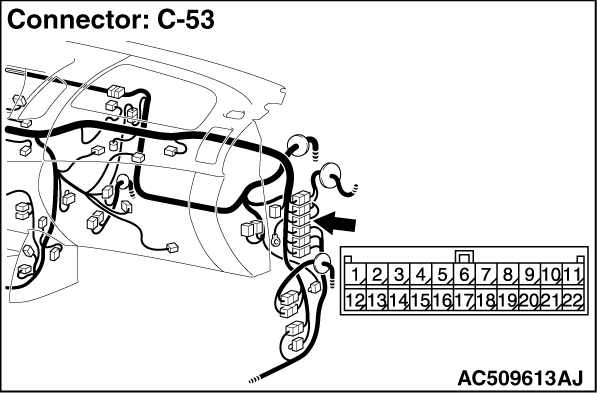
|
| caution |
The strand end of the twist wire should be within 10 cm from the connector. For details refer to  . .
|
Q.
Is the check result normal?
 Go to Step 2. Go to Step 2.
 Repair the defective connector. Repair the defective connector.
|


|
(1)Disconnect the connector, and measure at its female-side intermediate connector (at the instrument panel wiring harness side).
(2)Turn the ignition switch to the LOCK (OFF) position.
(3)
| caution |
When measuring the resistance, disconnect the negative battery terminal. For details refer to  . .
|
Ensure that the negative battery terminal is disconnected.
|

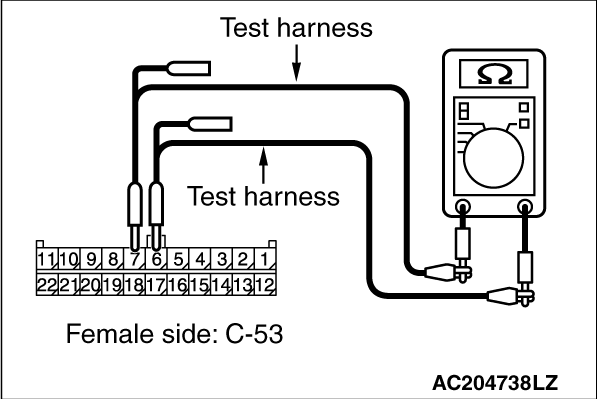
|
(4)Resistance between C-53 <LHD> or C-35 <RHD> intermediate connector terminal Nos.6 and 7
OK: 120 ±
20 Ω
Q.
Is the check result normal?
 <Within 120 ±
20 Ω>
Go to Step 3. <Within 120 ±
20 Ω>
Go to Step 3.
 <Not within 120 ±
20 Ω>
Go to Step 8. <Not within 120 ±
20 Ω>
Go to Step 8.
|

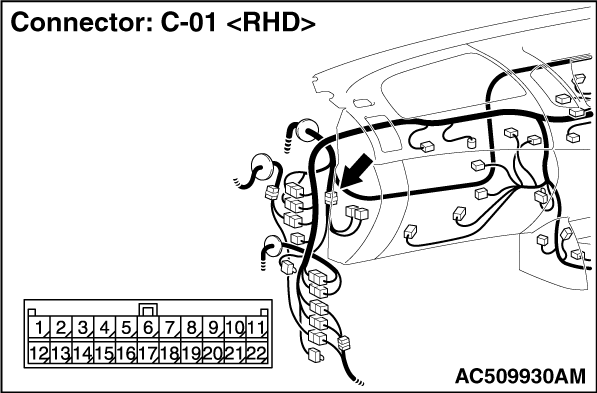
|
| caution |
The strand end of the twist wire should be within 10 cm from the connector. For details refer to  . .
|
|

|
When checking the joint connector, ensure that its wiring harness side and its short pins are not damaged.
Q.
Is the check result normal?
 Go to Step 4. Go to Step 4.
 Repair a defective connector or replace the joint connector. Repair a defective connector or replace the joint connector.
|


|
(1)Disconnect the connector, and measure at the wiring harness side.
(2)Turn the ignition switch to the LOCK (OFF) position.
(3)
| caution |
When measuring the resistance, disconnect the negative battery terminal. For details refer to  . .
|
Ensure that the negative battery terminal is disconnected.
|

|
(4)Resistance between C-01 joint connector (CAN2) terminal Nos.9 and 20 <LHD>
OK: 120 ±
20 Ω
|
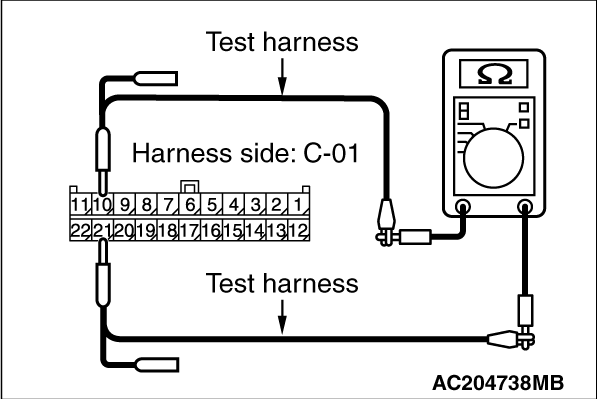
|
(5)Resistance between C-01 joint connector (CAN2) terminal Nos.10 and 21 <RHD>
OK: 120 ±
20 Ω
| caution |
Strictly observe the specified wiring harness repair procedure. For details refer to  . .
|
Q.
Is the check result normal?
YES <M/T> : <Within 120 ±
20 Ω>
Repair the wiring harness between joint connector (CAN2) and the engine-ECU connector.
YES <A/T> : <Within 120 ±
20 Ω>
Go to Step 6. : <Within 120 ±
20 Ω>
Go to Step 6.
NO  : <Not within 120 ±
20 Ω>
Go to Step 5. : <Not within 120 ±
20 Ω>
Go to Step 5.
|

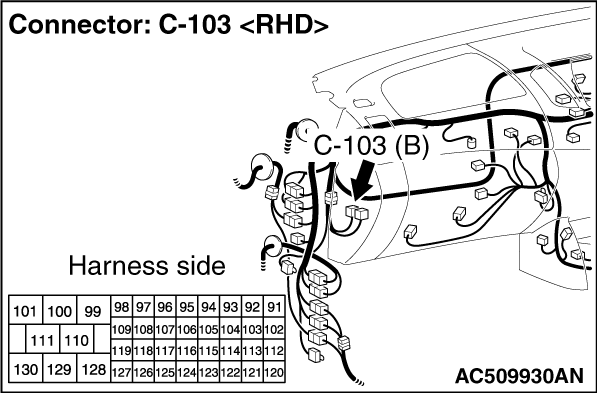
|
(1)Remove the engine-ECU, and measure at the equipment side.
|

|
(2)Resistance between C-103 engine-ECU connector terminal Nos.117 and 125
OK: 120 ±
20 Ω
| caution |
Strictly observe the specified wiring harness repair procedure. For details refer to  . .
|
Q.
Is the check result normal?
 <Within 120 ±
20 Ω>
Repair the wiring harness between joint connector (CAN2) and the engine-ECU connector. <Within 120 ±
20 Ω>
Repair the wiring harness between joint connector (CAN2) and the engine-ECU connector.
 <Not within 120 ±
20 Ω>
Check the engine-ECU connector, and repair if necessary. If the engine-ECU connector is in good condition, replace the engine-ECU. <Not within 120 ±
20 Ω>
Check the engine-ECU connector, and repair if necessary. If the engine-ECU connector is in good condition, replace the engine-ECU.
|


|
(1)Disconnect the connector, and measure at the wiring harness side.
(2)Turn the ignition switch to the LOCK (OFF) position.
(3)
| caution |
When measuring the resistance, disconnect the negative battery terminal. For details refer to  . .
|
Ensure that the negative battery terminal is disconnected.
|

|
(4)Resistance between C-01 joint connector (CAN2) terminal Nos.10 and 21 <LHD>
OK: 1 kΩ
or more
|

|
(5)Resistance between C-01 joint connector (CAN2) terminal Nos.9 and 20 <RHD>
OK: 1 kΩ
or more
| caution |
Strictly observe the specified wiring harness repair procedure. For details refer to  . .
|
Q.
Is the check result normal?
 <1 kΩ
or more>
Repair the wiring harness between joint connector (CAN2) and intermediate connector (C-53 <LHD> or C-35 <RHD>). <1 kΩ
or more>
Repair the wiring harness between joint connector (CAN2) and intermediate connector (C-53 <LHD> or C-35 <RHD>).
 <Less than 1 kΩ>
Go to Step 7. <Less than 1 kΩ>
Go to Step 7.
|


|
(1)Remove the A/T-ECU, and measure at the equipment side.
|

|
(2)Resistance between C-20 A/T-ECU connector terminal Nos.53 and 54
OK: 1 kΩ
or more
| caution |
Strictly observe the specified wiring harness repair procedure. For details refer to  . .
|
Q.
Is the check result normal?
 <1 kΩ
or more>
Repair the wiring harness between joint connector (CAN2) and the A/T-ECU connector. <1 kΩ
or more>
Repair the wiring harness between joint connector (CAN2) and the A/T-ECU connector.
 <Less than 1 kΩ>
Check the A/T-ECU connector, and repair if necessary. If the A/T-ECU connector is in good condition, replace the A/T-ECU. <Less than 1 kΩ>
Check the A/T-ECU connector, and repair if necessary. If the A/T-ECU connector is in good condition, replace the A/T-ECU.
|


|
| caution |
The strand end of the twist wire should be within 10 cm from the connector. For details refer to  . .
|
|

|
When checking the joint connector, ensure that its wiring harness side and its short pins are not damaged.
Q.
Is the check result normal?
 Go to Step 9. Go to Step 9.
 Repair a defective connector or replace the joint connector. Repair a defective connector or replace the joint connector.
|


|
(1)Disconnect joint connector (CAN1), and measure at the wiring harness side.
(2)Turn the ignition switch to the LOCK (OFF) position.
(3)
| caution |
When measuring the resistance, disconnect the negative battery terminal. For details refer to  . .
|
Ensure that the negative battery terminal is disconnected.
|

|
(4)Resistance between C-119 joint connector (CAN1) terminal Nos.9 and 20
OK: 120 ±
20 Ω
| caution |
Strictly observe the specified wiring harness repair procedure. For details refer to  . .
|
Q.
Is the check result normal?
 <Within 120 ±
20 Ω>
Go to Step 11. <Within 120 ±
20 Ω>
Go to Step 11.
 <Not within 120 ±
20 Ω>
Go to Step 10. <Not within 120 ±
20 Ω>
Go to Step 10.
|


|
(1)Remove the ETACS-ECU, and measure at the equipment side.
|
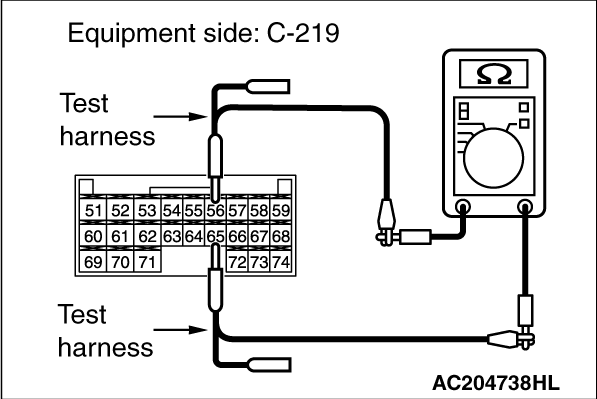
|
(2)Resistance at C-219 ETACS-ECU connector terminal Nos.56 and 65
OK: 120 ±
20 Ω
Q.
Is the check result normal?
 <Within 120 ±
20 Ω>
Repair the wiring harness between joint connector (CAN1) and the ETACS-ECU connector. <Within 120 ±
20 Ω>
Repair the wiring harness between joint connector (CAN1) and the ETACS-ECU connector.
 <Not within 120 ±
20 Ω>
Check the ETACS-ECU connector, and repair if necessary. If the ETACS-ECU connector is in good condition, replace the ETACS-ECU. <Not within 120 ±
20 Ω>
Check the ETACS-ECU connector, and repair if necessary. If the ETACS-ECU connector is in good condition, replace the ETACS-ECU.
|


|
(1)Disconnect joint connector (CAN1), and measure at the wiring harness side.
(2)Turn the ignition switch to the LOCK (OFF) position.
(3)
| caution |
When measuring the resistance, disconnect the negative battery terminal. For details refer to  . .
|
Ensure that the negative battery terminal is disconnected.
|

|
(4)Resistance between C-119 joint connector (CAN1) terminal Nos.8 and 19
OK: 120 ±
20 Ω
| caution |
Strictly observe the specified wiring harness repair procedure. For details refer to  . .
|
Q.
Is the check result normal?
YES <vehicles without RV meter, multi display station, ABS, ASTC and A/C> : <Within 120 ±
20 Ω>
Go to Step 27. : <Within 120 ±
20 Ω>
Go to Step 27.
YES <vehicles with RV meter> : <Within 120 ±
20 Ω>
Go to Step 13. : <Within 120 ±
20 Ω>
Go to Step 13.
YES <vehicles with multi display station> : <Within 120 ±
20 Ω>
Go to Step 15. : <Within 120 ±
20 Ω>
Go to Step 15.
YES <vehicles without RV meter and multi display station, and with ABS> : <Within 120 ±
20 Ω>
Go to Step 17. : <Within 120 ±
20 Ω>
Go to Step 17.
YES <vehicles without RV meter and multi display station, and with ASTC> : <Within 120 ±
20 Ω>
Go to Step 20. : <Within 120 ±
20 Ω>
Go to Step 20.
YES <vehicles without RV meter, multi display station, ABS and ASTC, and with A/C> : <Within 120 ±
20 Ω>
Go to Step 25. : <Within 120 ±
20 Ω>
Go to Step 25.
NO  : <Not within 120 ±
20 Ω>
Go to Step 12. : <Not within 120 ±
20 Ω>
Go to Step 12.
|
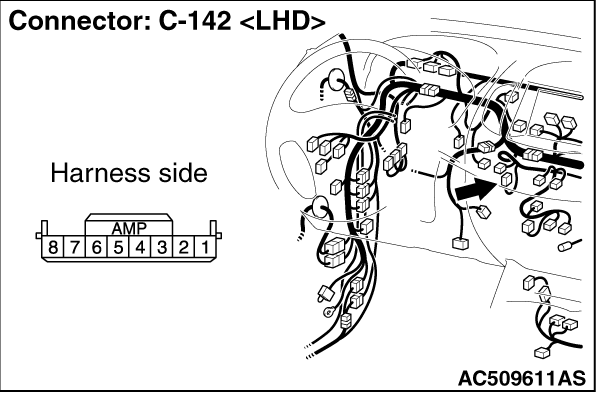
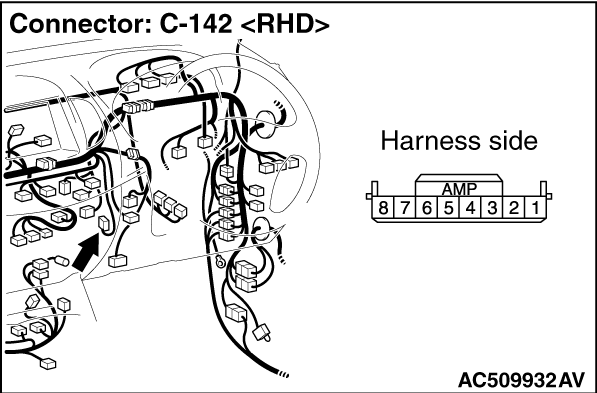
|
(1)Remove the immobilizer-ECU, and measure at the equipment side.
|

|
(2)Resistance at C-142 immobilizer-ECU connector terminal Nos.3 and 4
OK: 120 ±
20 Ω
Q.
Is the check result normal?
 <Within 120 ±
20 Ω>
Repair the wiring harness between joint connector (CAN1) and the immobilizer-ECU connector. <Within 120 ±
20 Ω>
Repair the wiring harness between joint connector (CAN1) and the immobilizer-ECU connector.
 <Not within 120 ±
20 Ω>
Check the immobilizer-ECU connector, and repair if necessary. If the immobilizer-ECU connector is in good condition, replace the immobilizer-ECU. <Not within 120 ±
20 Ω>
Check the immobilizer-ECU connector, and repair if necessary. If the immobilizer-ECU connector is in good condition, replace the immobilizer-ECU.
|


|
(1)Disconnect joint connector (CAN1), and measure at the wiring harness side.
(2)Turn the ignition switch to the LOCK (OFF) position.
(3)
| caution |
When measuring the resistance, disconnect the negative battery terminal. For details refer to  . .
|
Ensure that the negative battery terminal is disconnected.
|

|
(4)Resistance between C-119 joint connector (CAN1) terminal Nos.7 and 18
OK: 1 kΩ
or more
| caution |
Strictly observe the specified wiring harness repair procedure. For details refer to  . .
|
Q.
Is the check result normal?
YES <vehicles without ABS, ASTC and A/C> : <1 kΩ
or more>
Go to Step 27. : <1 kΩ
or more>
Go to Step 27.
YES <vehicles with ABS> : <1 kΩ
or more>
Go to Step 17. : <1 kΩ
or more>
Go to Step 17.
YES <vehicles with ASTC> : <1 kΩ
or more>
Go to Step 19. : <1 kΩ
or more>
Go to Step 19.
YES <vehicles without ABS and ASTC, and with A/C> : <1 kΩ
or more>
Go to Step 25. : <1 kΩ
or more>
Go to Step 25.
NO  : <Less than 1 kΩ>
Go to Step 14. : <Less than 1 kΩ>
Go to Step 14.
|


|
(1)Remove the CAN adapter, and measure at the equipment side.
|

|
(2)Resistance at C-110 CAN adapter connector terminal Nos.5 and 6
OK: 1 kΩ
or more
Q.
Is the check result normal?
 <1 kΩ
or more>
Repair the wiring harness between joint connector (CAN1) and the CAN adapter connector. <1 kΩ
or more>
Repair the wiring harness between joint connector (CAN1) and the CAN adapter connector.
 <Less than 1 kΩ>
Check the CAN adapter connector, and repair if necessary. If the CAN adapter connector is in good condition, replace the CAN adapter. <Less than 1 kΩ>
Check the CAN adapter connector, and repair if necessary. If the CAN adapter connector is in good condition, replace the CAN adapter.
|


|
(1)Disconnect joint connector (CAN1), and measure at the wiring harness side.
(2)Turn the ignition switch to the LOCK (OFF) position.
(3)
| caution |
When measuring the resistance, disconnect the negative battery terminal. For details refer to  . .
|
Ensure that the negative battery terminal is disconnected.
|

|
(4)Resistance between C-119 joint connector (CAN1) terminal Nos.7 and 18
OK: 1 kΩ
or more
| caution |
Strictly observe the specified wiring harness repair procedure. For details refer to  . .
|
Q.
Is the check result normal?
YES <vehicles without ABS, ASTC and A/C> : <1 kΩ
or more>
Go to Step 27. : <1 kΩ
or more>
Go to Step 27.
YES <vehicles with ABS> : <1 kΩ
or more>
Go to Step 17. : <1 kΩ
or more>
Go to Step 17.
YES <vehicles with ASTC> : <1 kΩ
or more>
Go to Step 19. : <1 kΩ
or more>
Go to Step 19.
YES <vehicles without ABS and ASTC, and with A/C> : <1 kΩ
or more>
Go to Step 25. : <1 kΩ
or more>
Go to Step 25.
NO  : <Less than 1 kΩ>
Go to Step 16. : <Less than 1 kΩ>
Go to Step 16.
|
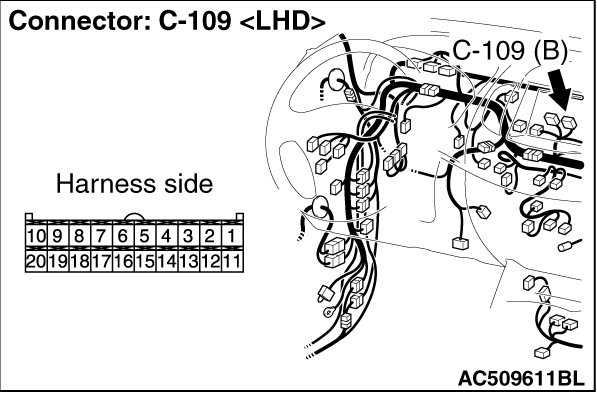

|
(1)Remove the multi display station, and measure at the equipment side.
|
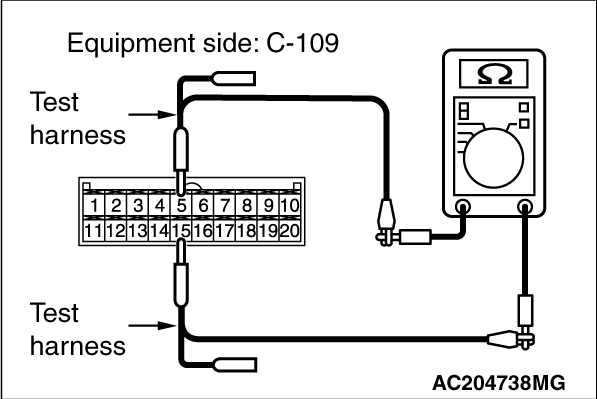
|
(2)Resistance at C-109 multi display station connector terminal Nos.5 and 15
OK: 1 kΩ
or more
Q.
Is the check result normal?
 <1 kΩ
or more>
Check jumper connector (C-110), and repair if necessary. If the jumper connector (C-110) is in good condition, repair the wiring harness between joint connector (CAN1) and the multi display station connector. <1 kΩ
or more>
Check jumper connector (C-110), and repair if necessary. If the jumper connector (C-110) is in good condition, repair the wiring harness between joint connector (CAN1) and the multi display station connector.
 <Less than 1 kΩ>
Check the multi display station connector, and repair if necessary. If the multi display station connector is in good condition, replace the multi display station. <Less than 1 kΩ>
Check the multi display station connector, and repair if necessary. If the multi display station connector is in good condition, replace the multi display station.
|


|
(1)Disconnect joint connector (CAN1), and measure at the wiring harness side.
(2)Turn the ignition switch to the LOCK (OFF) position.
(3)
| caution |
When measuring the resistance, disconnect the negative battery terminal. For details refer to  . .
|
Ensure that the negative battery terminal is disconnected.
|
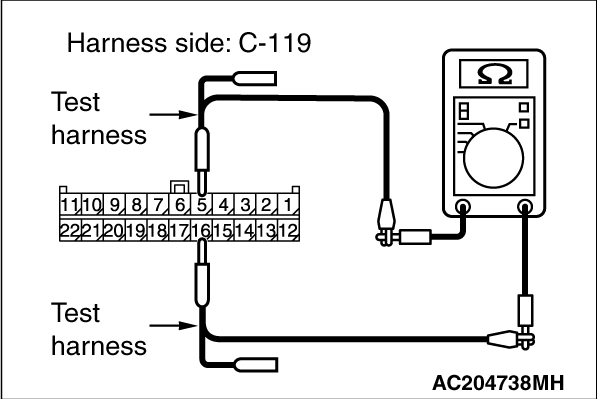
|
(4)Resistance between C-119 joint connector (CAN1) terminal Nos.5 and 16
OK: 1 kΩ
or more
| caution |
Strictly observe the specified wiring harness repair procedure. For details refer to  . .
|
Q.
Is the check result normal?
YES <vehicles without A/C> : <1 kΩ
or more>
Go to Step 27. : <1 kΩ
or more>
Go to Step 27.
YES <vehicles with A/C> : <1 kΩ
or more>
Go to Step 25. : <1 kΩ
or more>
Go to Step 25.
NO  : <Less than 1 kΩ>
Go to Step 18. : <Less than 1 kΩ>
Go to Step 18.
|

|
(1)Remove the ABS-ECU, and measure at the equipment side.
|

|
(2)Resistance at A-01 ABS-ECU connector terminal Nos.7 and 8
OK: 1 kΩ
or more
Q.
Is the check result normal?
 <1 kΩ
or more>
Check intermediate connector (C-13), and repair if necessary. If the intermediate connector (C-13) is in good condition, repair the wiring harness between joint connector (CAN1) and the ABS-ECU connector. <1 kΩ
or more>
Check intermediate connector (C-13), and repair if necessary. If the intermediate connector (C-13) is in good condition, repair the wiring harness between joint connector (CAN1) and the ABS-ECU connector.
 <Less than 1 kΩ>
Check the ABS-ECU connector, and repair if necessary. If the ABS-ECU connector is in good condition, replace the hydraulic unit assembly. <Less than 1 kΩ>
Check the ABS-ECU connector, and repair if necessary. If the ABS-ECU connector is in good condition, replace the hydraulic unit assembly.
|


|
(1)Disconnect joint connector (CAN1), and measure at the wiring harness side.
(2)Turn the ignition switch to the LOCK (OFF) position.
(3)
| caution |
When measuring the resistance, disconnect the negative battery terminal. For details refer to  . .
|
Ensure that the negative battery terminal is disconnected.
|

|
(4)Resistance between C-119 joint connector (CAN1) terminal Nos.5 and 16
OK: 1 kΩ
or more
| caution |
Strictly observe the specified wiring harness repair procedure. For details refer to  . .
|
Q.
Is the check result normal?
 <1 kΩ
or more>
Go to Step 21. <1 kΩ
or more>
Go to Step 21.
 <Less than 1 kΩ>
Go to Step 20. <Less than 1 kΩ>
Go to Step 20.
|
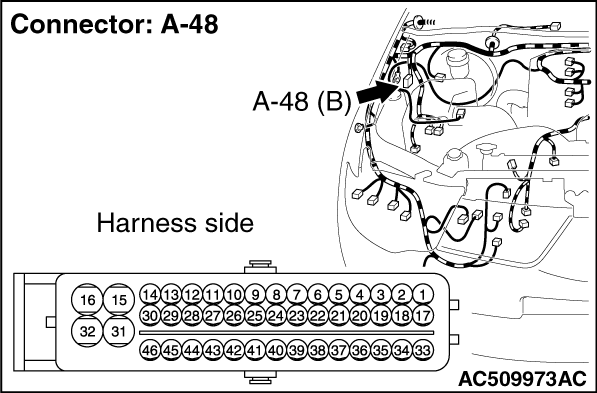
|
(1)Remove the ASTC-ECU, and measure at the equipment side.
|

|
(2)Resistance at A-48 ASTC-ECU connector terminal Nos.6 and 22
OK: 1 kΩ
or more
Q.
Is the check result normal?
 <1 kΩ
or more>
Check intermediate connector (C-13), and repair if necessary. If the intermediate connector (C-13) is in good condition, repair the wiring harness between joint connector (CAN1) and the ASTC-ECU connector. <1 kΩ
or more>
Check intermediate connector (C-13), and repair if necessary. If the intermediate connector (C-13) is in good condition, repair the wiring harness between joint connector (CAN1) and the ASTC-ECU connector.
 <Less than 1 kΩ>
Check the ASTC-ECU connector, and repair if necessary. If the ASTC-ECU connector is in good condition, replace the hydraulic unit assembly. <Less than 1 kΩ>
Check the ASTC-ECU connector, and repair if necessary. If the ASTC-ECU connector is in good condition, replace the hydraulic unit assembly.
|


|
(1)Disconnect joint connector (CAN1), and measure at the wiring harness side.
(2)Turn the ignition switch to the LOCK (OFF) position.
(3)
| caution |
When measuring the resistance, disconnect the negative battery terminal. For details refer to  . .
|
Ensure that the negative battery terminal is disconnected.
|
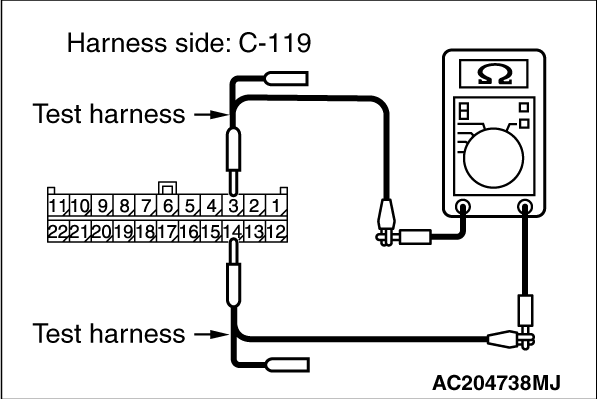
|
(4)Resistance between C-119 joint connector (CAN1) terminal Nos.3 and 14
OK: 1 kΩ
or more
| caution |
Strictly observe the specified wiring harness repair procedure. For details refer to  . .
|
Q.
Is the check result normal?
 <1 kΩ
or more>
Go to Step 23. <1 kΩ
or more>
Go to Step 23.
 <Less than 1 kΩ>
Go to Step 22. <Less than 1 kΩ>
Go to Step 22.
|
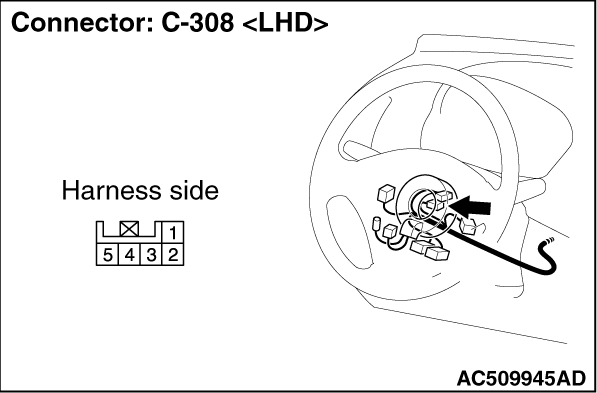

|
(1)Remove the steering wheel sensor, and measure at the equipment side.
|
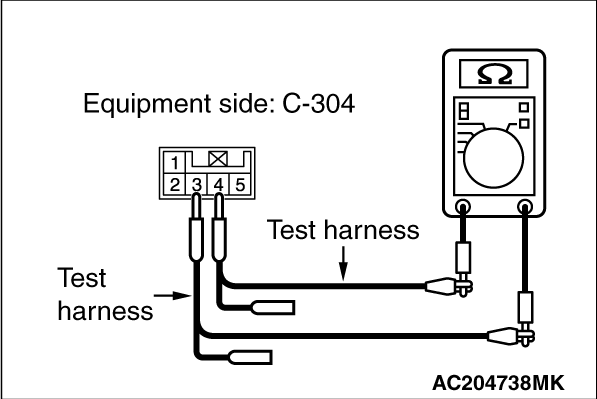
|
(2)Resistance at C-308 steering wheel sensor connector terminal Nos.3 and 4
OK: 1 kΩ
or more
Q.
Is the check result normal?
 <1 kΩ
or more>
Repair the wiring harness between joint connector (CAN1) and the steering wheel sensor connector. <1 kΩ
or more>
Repair the wiring harness between joint connector (CAN1) and the steering wheel sensor connector.
 <Less than 1 kΩ>
Check the steering wheel sensor connector, and repair if necessary. If the steering wheel sensor connector is in good condition, replace the steering wheel sensor. <Less than 1 kΩ>
Check the steering wheel sensor connector, and repair if necessary. If the steering wheel sensor connector is in good condition, replace the steering wheel sensor.
|


|
(1)Disconnect joint connector (CAN1), and measure at the wiring harness side.
(2)Turn the ignition switch to the LOCK (OFF) position.
(3)
| caution |
When measuring the resistance, disconnect the negative battery terminal. For details refer to  . .
|
Ensure that the negative battery terminal is disconnected.
|

|
(4)Resistance between C-119 joint connector (CAN1) terminal Nos.4 and 15
OK: 1 kΩ
or more
| caution |
Strictly observe the specified wiring harness repair procedure. For details refer to  . .
|
Q.
Is the check result normal?
YES <vehicles without A/C> : <1 kΩ
or more>
Go to Step 27. : <1 kΩ
or more>
Go to Step 27.
YES <vehicles with A/C> : <1 kΩ
or more>
Go to Step 25. : <1 kΩ
or more>
Go to Step 25.
 <Less than 1 kΩ>
Go to Step 24. <Less than 1 kΩ>
Go to Step 24.
|


|
(1)Remove the G and yaw rate sensor, and measure at the equipment side.
|

|
(2)Resistance at C-144 G and yaw rate sensor connector terminal Nos.2 and 3
OK: 1 kΩ
or more
Q.
Is the check result normal?
 <1 kΩ
or more>
Repair the wiring harness between joint connector (CAN1) and the G and yaw rate sensor connector. <1 kΩ
or more>
Repair the wiring harness between joint connector (CAN1) and the G and yaw rate sensor connector.
 <Less than 1 kΩ>
Check the G and yaw rate sensor connector, and repair if necessary. If the G and yaw rate sensor connector is in good condition, replace the G and yaw rate sensor. <Less than 1 kΩ>
Check the G and yaw rate sensor connector, and repair if necessary. If the G and yaw rate sensor connector is in good condition, replace the G and yaw rate sensor.
|


|
(1)Disconnect joint connector (CAN1), and measure at the wiring harness side.
(2)Turn the ignition switch to the LOCK (OFF) position.
(3)
| caution |
When measuring the resistance, disconnect the negative battery terminal. For details refer to  . .
|
Ensure that the negative battery terminal is disconnected.
|

|
(4)Resistance between C-119 joint connector (CAN1) terminal Nos.6 and 17
OK: 1 kΩ
or more
| caution |
Strictly observe the specified wiring harness repair procedure. For details refer to  . .
|
Q.
Is the check result normal?
 <1 kΩ
or more>
Go to Step 27. <1 kΩ
or more>
Go to Step 27.
 <Less than 1 kΩ>
Go to Step 26. <Less than 1 kΩ>
Go to Step 26.
|

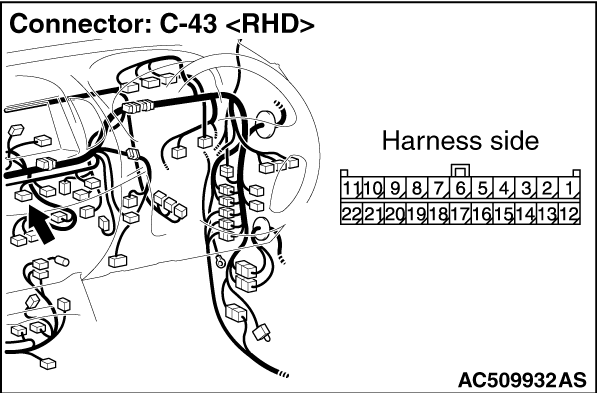
|
(1)Remove the A/C-ECU, and measure at the equipment side.
|

|
(2)Resistance at C-43 A/C-ECU connector terminal Nos.6 and 7
OK: 1 kΩ
or more
Q.
Is the check result normal?
 <1 kΩ
or more>
Repair the wiring harness between joint connector (CAN1) and the A/C-ECU connector. <1 kΩ
or more>
Repair the wiring harness between joint connector (CAN1) and the A/C-ECU connector.
 <Less than 1 kΩ>
Check the A/C-ECU connector, and repair if necessary. If the A/C-ECU connector is in good condition, replace the A/C-ECU. <Less than 1 kΩ>
Check the A/C-ECU connector, and repair if necessary. If the A/C-ECU connector is in good condition, replace the A/C-ECU.
|


|
(1)Disconnect the joint connector (CAN1), and measure at the wiring harness side.
(2)Turn the ignition switch to the LOCK (OFF) position.
(3)
| caution |
When measuring the resistance, disconnect the negative battery terminal. For details refer to  . .
|
Ensure that the negative battery terminal is disconnected.
|

|
(4)Resistance between C-119 joint connector (CAN1) terminal Nos.2 and 13
OK: 1 kΩ
or more
| caution |
Strictly observe the specified wiring harness repair procedure. For details refer to  . .
|
Q.
Is the check result normal?
 <1 kΩ
or more>
Repair the wiring harness between joint connector (CAN1) and the intermediate connector (C-53 <LHD> or C-35 <RHD>). <1 kΩ
or more>
Repair the wiring harness between joint connector (CAN1) and the intermediate connector (C-53 <LHD> or C-35 <RHD>).
 <Less than 1 kΩ>
Check the diagnosis connector, and repair if necessary. If the diagnosis connector is in good condition, repair the wiring harness between joint connector (CAN1) and the diagnosis connector. <Less than 1 kΩ>
Check the diagnosis connector, and repair if necessary. If the diagnosis connector is in good condition, repair the wiring harness between joint connector (CAN1) and the diagnosis connector.
|


 .
. Go to Step 2.
Go to Step 2. Repair the defective connector.
Repair the defective connector.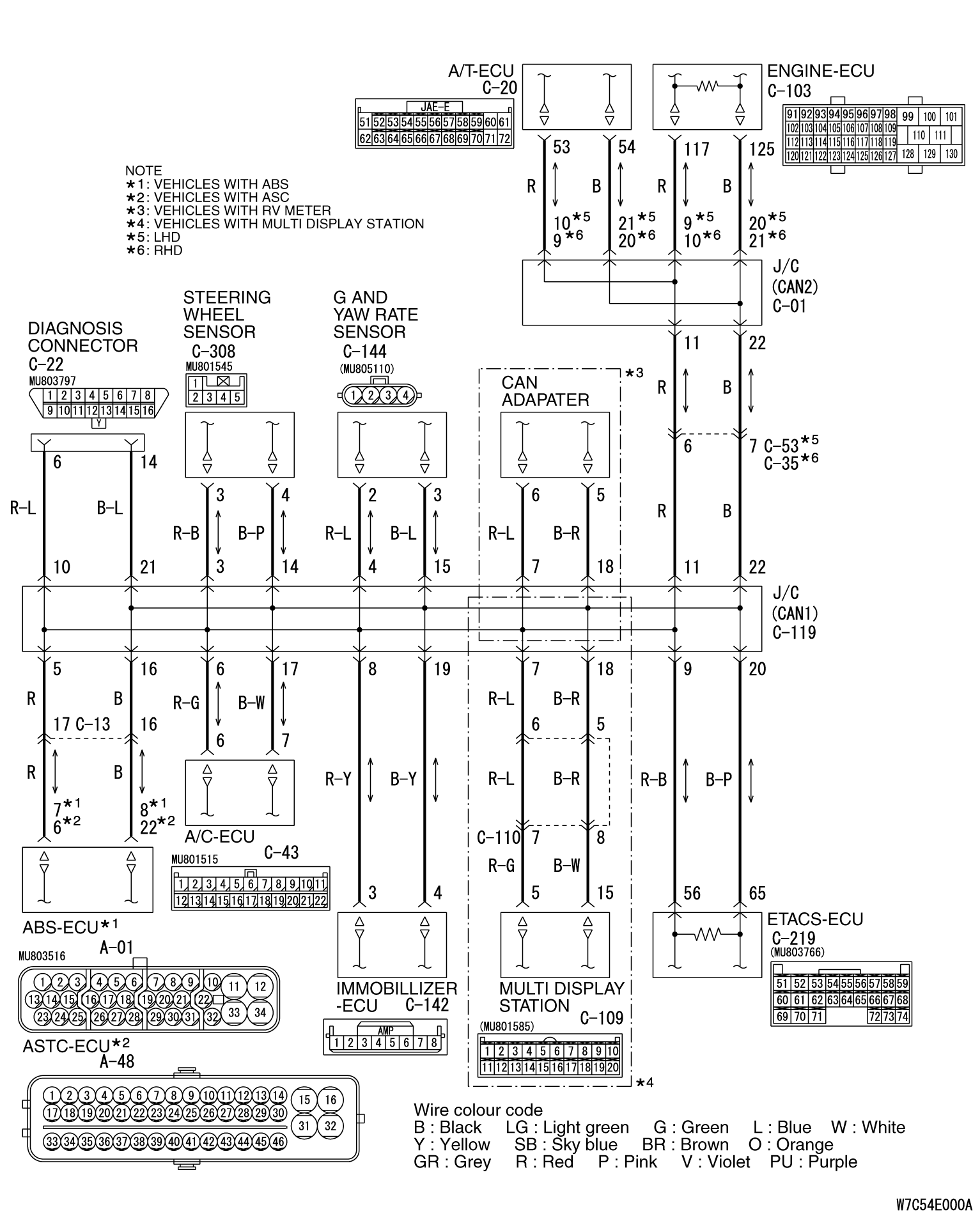


 Go to Step 2.
Go to Step 2. Repair the defective connector.
Repair the defective connector.

 <Within 120 ±
20 Ω>
Go to Step 3.
<Within 120 ±
20 Ω>
Go to Step 3. <Not within 120 ±
20 Ω>
Go to Step 8.
<Not within 120 ±
20 Ω>
Go to Step 8.


 Go to Step 4.
Go to Step 4. Repair a defective connector or replace the joint connector.
Repair a defective connector or replace the joint connector.



 : <Within 120 ±
20 Ω>
Go to Step 6.
: <Within 120 ±
20 Ω>
Go to Step 6. : <Not within 120 ±
20 Ω>
Go to Step 5.
: <Not within 120 ±
20 Ω>
Go to Step 5.


 <Within 120 ±
20 Ω>
Repair the wiring harness between joint connector (CAN2) and the engine-ECU connector.
<Within 120 ±
20 Ω>
Repair the wiring harness between joint connector (CAN2) and the engine-ECU connector. <Not within 120 ±
20 Ω>
Check the engine-ECU connector, and repair if necessary. If the engine-ECU connector is in good condition, replace the engine-ECU.
<Not within 120 ±
20 Ω>
Check the engine-ECU connector, and repair if necessary. If the engine-ECU connector is in good condition, replace the engine-ECU.



 <1 kΩ
or more>
Repair the wiring harness between joint connector (CAN2) and intermediate connector (C-53 <LHD> or C-35 <RHD>).
<1 kΩ
or more>
Repair the wiring harness between joint connector (CAN2) and intermediate connector (C-53 <LHD> or C-35 <RHD>). <Less than 1 kΩ>
Go to Step 7.
<Less than 1 kΩ>
Go to Step 7.


 <1 kΩ
or more>
Repair the wiring harness between joint connector (CAN2) and the A/T-ECU connector.
<1 kΩ
or more>
Repair the wiring harness between joint connector (CAN2) and the A/T-ECU connector. <Less than 1 kΩ>
Check the A/T-ECU connector, and repair if necessary. If the A/T-ECU connector is in good condition, replace the A/T-ECU.
<Less than 1 kΩ>
Check the A/T-ECU connector, and repair if necessary. If the A/T-ECU connector is in good condition, replace the A/T-ECU.


 Go to Step 9.
Go to Step 9. Repair a defective connector or replace the joint connector.
Repair a defective connector or replace the joint connector.


 <Within 120 ±
20 Ω>
Go to Step 11.
<Within 120 ±
20 Ω>
Go to Step 11. <Not within 120 ±
20 Ω>
Go to Step 10.
<Not within 120 ±
20 Ω>
Go to Step 10.


 <Within 120 ±
20 Ω>
Repair the wiring harness between joint connector (CAN1) and the ETACS-ECU connector.
<Within 120 ±
20 Ω>
Repair the wiring harness between joint connector (CAN1) and the ETACS-ECU connector. <Not within 120 ±
20 Ω>
Check the ETACS-ECU connector, and repair if necessary. If the ETACS-ECU connector is in good condition, replace the ETACS-ECU.
<Not within 120 ±
20 Ω>
Check the ETACS-ECU connector, and repair if necessary. If the ETACS-ECU connector is in good condition, replace the ETACS-ECU.


 : <Within 120 ±
20 Ω>
Go to Step 27.
: <Within 120 ±
20 Ω>
Go to Step 27. : <Within 120 ±
20 Ω>
Go to Step 13.
: <Within 120 ±
20 Ω>
Go to Step 13. : <Within 120 ±
20 Ω>
Go to Step 15.
: <Within 120 ±
20 Ω>
Go to Step 15. : <Within 120 ±
20 Ω>
Go to Step 17.
: <Within 120 ±
20 Ω>
Go to Step 17. : <Within 120 ±
20 Ω>
Go to Step 20.
: <Within 120 ±
20 Ω>
Go to Step 20. : <Within 120 ±
20 Ω>
Go to Step 25.
: <Within 120 ±
20 Ω>
Go to Step 25. : <Not within 120 ±
20 Ω>
Go to Step 12.
: <Not within 120 ±
20 Ω>
Go to Step 12.


 <Within 120 ±
20 Ω>
Repair the wiring harness between joint connector (CAN1) and the immobilizer-ECU connector.
<Within 120 ±
20 Ω>
Repair the wiring harness between joint connector (CAN1) and the immobilizer-ECU connector. <Not within 120 ±
20 Ω>
Check the immobilizer-ECU connector, and repair if necessary. If the immobilizer-ECU connector is in good condition, replace the immobilizer-ECU.
<Not within 120 ±
20 Ω>
Check the immobilizer-ECU connector, and repair if necessary. If the immobilizer-ECU connector is in good condition, replace the immobilizer-ECU.


 : <1 kΩ
or more>
Go to Step 27.
: <1 kΩ
or more>
Go to Step 27. : <1 kΩ
or more>
Go to Step 17.
: <1 kΩ
or more>
Go to Step 17. : <1 kΩ
or more>
Go to Step 19.
: <1 kΩ
or more>
Go to Step 19. : <1 kΩ
or more>
Go to Step 25.
: <1 kΩ
or more>
Go to Step 25. : <Less than 1 kΩ>
Go to Step 14.
: <Less than 1 kΩ>
Go to Step 14.


 <1 kΩ
or more>
Repair the wiring harness between joint connector (CAN1) and the CAN adapter connector.
<1 kΩ
or more>
Repair the wiring harness between joint connector (CAN1) and the CAN adapter connector. <Less than 1 kΩ>
Check the CAN adapter connector, and repair if necessary. If the CAN adapter connector is in good condition, replace the CAN adapter.
<Less than 1 kΩ>
Check the CAN adapter connector, and repair if necessary. If the CAN adapter connector is in good condition, replace the CAN adapter.


 : <1 kΩ
or more>
Go to Step 27.
: <1 kΩ
or more>
Go to Step 27. : <1 kΩ
or more>
Go to Step 17.
: <1 kΩ
or more>
Go to Step 17. : <1 kΩ
or more>
Go to Step 19.
: <1 kΩ
or more>
Go to Step 19. : <1 kΩ
or more>
Go to Step 25.
: <1 kΩ
or more>
Go to Step 25. : <Less than 1 kΩ>
Go to Step 16.
: <Less than 1 kΩ>
Go to Step 16.


 <1 kΩ
or more>
Check jumper connector (C-110), and repair if necessary. If the jumper connector (C-110) is in good condition, repair the wiring harness between joint connector (CAN1) and the multi display station connector.
<1 kΩ
or more>
Check jumper connector (C-110), and repair if necessary. If the jumper connector (C-110) is in good condition, repair the wiring harness between joint connector (CAN1) and the multi display station connector. <Less than 1 kΩ>
Check the multi display station connector, and repair if necessary. If the multi display station connector is in good condition, replace the multi display station.
<Less than 1 kΩ>
Check the multi display station connector, and repair if necessary. If the multi display station connector is in good condition, replace the multi display station.


 : <1 kΩ
or more>
Go to Step 27.
: <1 kΩ
or more>
Go to Step 27. : <1 kΩ
or more>
Go to Step 25.
: <1 kΩ
or more>
Go to Step 25. : <Less than 1 kΩ>
Go to Step 18.
: <Less than 1 kΩ>
Go to Step 18.

 <1 kΩ
or more>
Check intermediate connector (C-13), and repair if necessary. If the intermediate connector (C-13) is in good condition, repair the wiring harness between joint connector (CAN1) and the ABS-ECU connector.
<1 kΩ
or more>
Check intermediate connector (C-13), and repair if necessary. If the intermediate connector (C-13) is in good condition, repair the wiring harness between joint connector (CAN1) and the ABS-ECU connector. <Less than 1 kΩ>
Check the ABS-ECU connector, and repair if necessary. If the ABS-ECU connector is in good condition, replace the hydraulic unit assembly.
<Less than 1 kΩ>
Check the ABS-ECU connector, and repair if necessary. If the ABS-ECU connector is in good condition, replace the hydraulic unit assembly.


 <1 kΩ
or more>
Go to Step 21.
<1 kΩ
or more>
Go to Step 21. <Less than 1 kΩ>
Go to Step 20.
<Less than 1 kΩ>
Go to Step 20.

 <1 kΩ
or more>
Check intermediate connector (C-13), and repair if necessary. If the intermediate connector (C-13) is in good condition, repair the wiring harness between joint connector (CAN1) and the ASTC-ECU connector.
<1 kΩ
or more>
Check intermediate connector (C-13), and repair if necessary. If the intermediate connector (C-13) is in good condition, repair the wiring harness between joint connector (CAN1) and the ASTC-ECU connector. <Less than 1 kΩ>
Check the ASTC-ECU connector, and repair if necessary. If the ASTC-ECU connector is in good condition, replace the hydraulic unit assembly.
<Less than 1 kΩ>
Check the ASTC-ECU connector, and repair if necessary. If the ASTC-ECU connector is in good condition, replace the hydraulic unit assembly.


 <1 kΩ
or more>
Go to Step 23.
<1 kΩ
or more>
Go to Step 23. <Less than 1 kΩ>
Go to Step 22.
<Less than 1 kΩ>
Go to Step 22.


 <1 kΩ
or more>
Repair the wiring harness between joint connector (CAN1) and the steering wheel sensor connector.
<1 kΩ
or more>
Repair the wiring harness between joint connector (CAN1) and the steering wheel sensor connector. <Less than 1 kΩ>
Check the steering wheel sensor connector, and repair if necessary. If the steering wheel sensor connector is in good condition, replace the steering wheel sensor.
<Less than 1 kΩ>
Check the steering wheel sensor connector, and repair if necessary. If the steering wheel sensor connector is in good condition, replace the steering wheel sensor.


 : <1 kΩ
or more>
Go to Step 27.
: <1 kΩ
or more>
Go to Step 27. : <1 kΩ
or more>
Go to Step 25.
: <1 kΩ
or more>
Go to Step 25. <Less than 1 kΩ>
Go to Step 24.
<Less than 1 kΩ>
Go to Step 24.


 <1 kΩ
or more>
Repair the wiring harness between joint connector (CAN1) and the G and yaw rate sensor connector.
<1 kΩ
or more>
Repair the wiring harness between joint connector (CAN1) and the G and yaw rate sensor connector. <Less than 1 kΩ>
Check the G and yaw rate sensor connector, and repair if necessary. If the G and yaw rate sensor connector is in good condition, replace the G and yaw rate sensor.
<Less than 1 kΩ>
Check the G and yaw rate sensor connector, and repair if necessary. If the G and yaw rate sensor connector is in good condition, replace the G and yaw rate sensor.


 <1 kΩ
or more>
Go to Step 27.
<1 kΩ
or more>
Go to Step 27. <Less than 1 kΩ>
Go to Step 26.
<Less than 1 kΩ>
Go to Step 26.


 <1 kΩ
or more>
Repair the wiring harness between joint connector (CAN1) and the A/C-ECU connector.
<1 kΩ
or more>
Repair the wiring harness between joint connector (CAN1) and the A/C-ECU connector. <Less than 1 kΩ>
Check the A/C-ECU connector, and repair if necessary. If the A/C-ECU connector is in good condition, replace the A/C-ECU.
<Less than 1 kΩ>
Check the A/C-ECU connector, and repair if necessary. If the A/C-ECU connector is in good condition, replace the A/C-ECU.


 <1 kΩ
or more>
Repair the wiring harness between joint connector (CAN1) and the intermediate connector (C-53 <LHD> or C-35 <RHD>).
<1 kΩ
or more>
Repair the wiring harness between joint connector (CAN1) and the intermediate connector (C-53 <LHD> or C-35 <RHD>). <Less than 1 kΩ>
Check the diagnosis connector, and repair if necessary. If the diagnosis connector is in good condition, repair the wiring harness between joint connector (CAN1) and the diagnosis connector.
<Less than 1 kΩ>
Check the diagnosis connector, and repair if necessary. If the diagnosis connector is in good condition, repair the wiring harness between joint connector (CAN1) and the diagnosis connector.